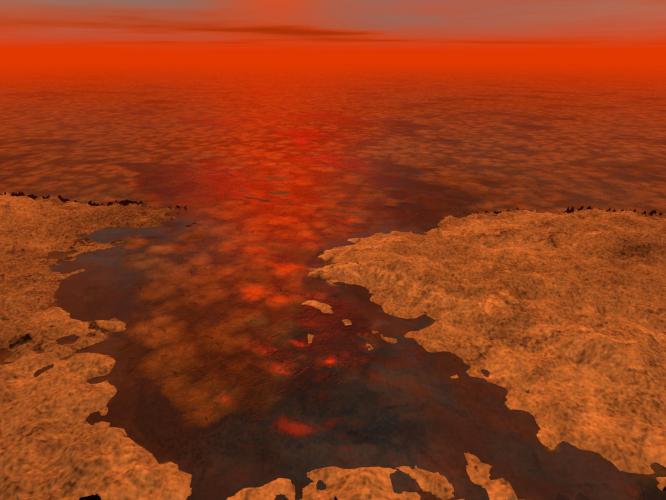Please note: The Academy will close at 3 pm today for Big Bang Gala.
Science News
Titan's Missing Waves
July 25, 2013
by Alyssa Keimach

Roughly 70% water, Earth’s surface is covered with rivers, lakes, oceans, mud, and rain clouds. Scientists searching for alien life are searching for planets similar to our own, because experience tells us that life needs water in order to survive.
NASA’s Cassini spacecraft began photographing Titan, one of Saturn’s moons, in 2004. The pictures beamed back to Earth depict strange lakes and rivers. The European Space Agency (ESA)’s Huygens probe splashed into Titan’s mud in 2005, further convincing researchers that Titan was indeed “wet.”
The scientific community agrees that Titan appears Earth-like, but at temperatures around –290°F (–180°C), any water would be in the form of ice. Instead, astronomers believe any wetness on the surface of Titan is a combination of liquid methane, ethane, and other hard-to-freeze elements.
Apparently this moon doesn’t resemble Earth at all. Alex Hayes, a planetary scientist at Cornell University who works on the Cassini radar team, noticed something eerie while observing Saturn’s moon. “Where are all the waves?”
Wind, raindrops, and tides move Earth’s water in every direction. But Cassini has detected no wave action on Titan. It’s pretty strange, especially because, “[w]e know there is wind on Titan, the moon’s magnificent sand dunes prove it,” says Hayes.
Taking into account Titan’s gravity (one seventh that of Earth’s), the nature of fluids on its surface, and its dense atmosphere, Hayes and his colleagues calculated and published the speed needed for waves to form: only two miles per hour!
A strange puzzle, with even stranger solutions. Maybe the lakes are covered with tar, damping wave motion. Or they might be frozen. Or perhaps the wind hasn’t reached two miles per hour… yet.
Most of the lakes are located on Titan’s northern hemisphere, where it has been winter for a few years. The air during winter is colder and thicker, and may be the secret behind the missing waves.
If current climate models are correct, Cassini should be able to detect waves as Titan nears its summer solstice in 2017. Measurements and calculations of waves formed during the summer could tell us the chemical composition of Titan’s lakes… And reveal more about this Earth-like world so unlike Earth.
Alyssa Keimach is an astronomy and astrophysics student at the University of Michigan and interns for the Morrison Planetarium.
Image: NASA/JPL-Caltech/USGS